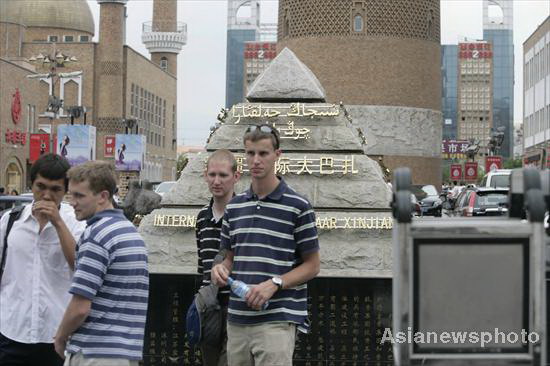Society
One year on, Urumqi shakes off riot shadow
(Xinhua)
Updated: 2010-07-04 19:25
 |
Large Medium Small |
|
 Foreign tourists are seen on the street of Urumqi, capital of Northwest China's Xinjiang Uygur autonomous region on July 3, 2010. Urumqi has maintained good law and order ahead of the anniversary of a riot that left almost 200 people dead in the city last year. [Photo/Asianewsphoto] |
URUMQI - Ma Ming, from Northwest China's Gansu province, sells lavender oil in the International Grand Bazaar in Urumqi, capital of Xinjiang Uygur autonomous region, in China's far west.
He says he's on good terms with neighboring Uygur vendors. "We usually look after each other's businesses when either of us is not here."
The landmark Bazaar, with 4,000 shops and booths, is a 100,000-square-meter complex in an Islamic-style building that includes a banquet hall, food court, viewing tower, open-air stage and a mosque.
It was closed the day after the riot in Urumqi that left 197 people dead and more than 1,600 others injured on July 5 last year. It reopened 17 days later, but stall-holders were exempted from rents for much longer to make up for the downturn in trade.
A year on, Unity Road in front of the bazaar is crowded with people and vehicles. Two tour buses are parked at the roadside. A guide, with a flag of his travel agency in hand, is followed by curious visitors, taking in the first stop on their city tour.
Officials reckon the city's major hotels have a 60-percent occupancy rate since the government unveiled a major support package to boost development in Xinjiang in May. Airlines and railways have increased services to Urumqi, carrying government delegations from other Chinese regions and business travelers.
And the tourists are everywhere. At Red Hill Park in central Urumqi, the best place for a bird's eye view of the city, they climb to the top of the hill to take pictures.
Wu Yi Night Market, where mutton shashliks and Xinjiang rice (to be authentic, one eats it by hand) are served up with beer, is expecting 40,000 people a night from July to October.
Healing wounds
Normal life has resumed, but under the watchful eyes of police, who patrol the streets and alleys armed with batons and shields.
The city's 3.5 million inhabitants have become accustomed to the heavy security. A young couple kiss on a bench as police in camouflage fatigues march by, but neither the police nor the couple notice each other.
Meanwhile, retired women wearing red armbands, members of the "joint defense teams for public security," offer help to strangers.
In a Geely Motor showroom, large photos hanging on the wall show scenes from the deadly riot. The showroom was looted and vandalized by rioters, with losses of more than 6 million yuan ($882,000).
Sales manager Wang Xiangrong says business has been climbing steadily since it reopened in December, but it has yet to reach pre-riot levels.
Uygur dancing -- suspended after the riot -- has resumed at the Flaming Mountain Steamboat Restaurant, while in Apple's Father Restaurant, young Uygurs, Kazakhs and Han people dance to pop and Kazakh music.
Excavators move back and forth at Heijiashan Area, Tianshan district, demolishing one of Urumqi's shanty towns, which used to house 200,000 people. Most of the homes in Heijiashan had no utilities, gas or heating, and the area was considered a hotbed of crime and poverty.
Ablikim Mamet is negotiating with community workers on a contract for compensation for the demolition of his home. He has been in a dispute with the government on the total area of his 440-square-meter bungalow, half of which was unlicensed. He hopes to move into a new home after he reaches an agreement.
Ahat Wujit is a Uygur resident of Erdaowan East Community, where people from seven ethnic groups, including Han, Hui, Uygur and Mongolian, live. "I've seen many Han people learn Uygur dances on the square, and my wife usually dances with them. We never feel estranged.
"The rioters damaged our image and reputation, but my Han neighbors are still kind to us. I am grateful to them," Ahat says.
Alygul Parhat, a Uygur woman of 25, who lives in the community, left her mobile phone in a taxi after paying the driver and getting out.
"I dialed my number on my husband's mobile, but no one answered. I thought I had lost my cell phone. But later the Han driver called back and returned it to me," Alygul says.
"If we can help each other on small matters, then we can help each other when big things happen."



